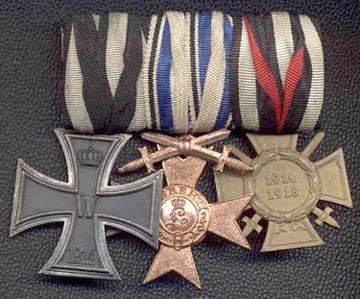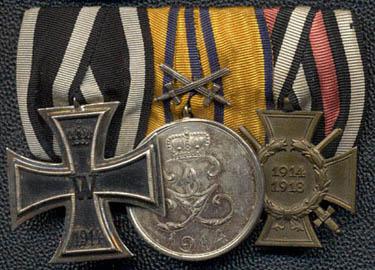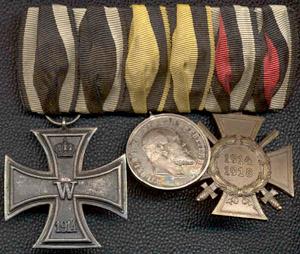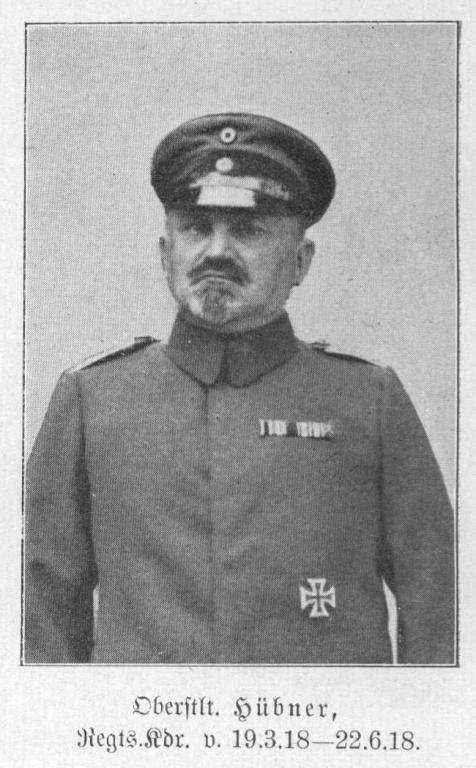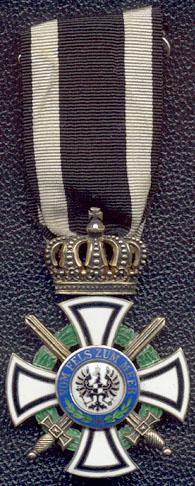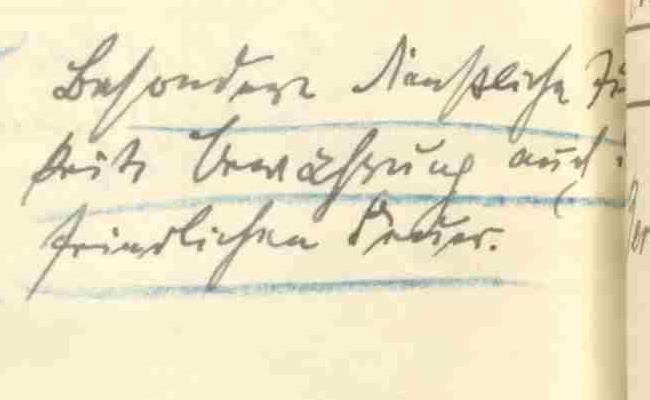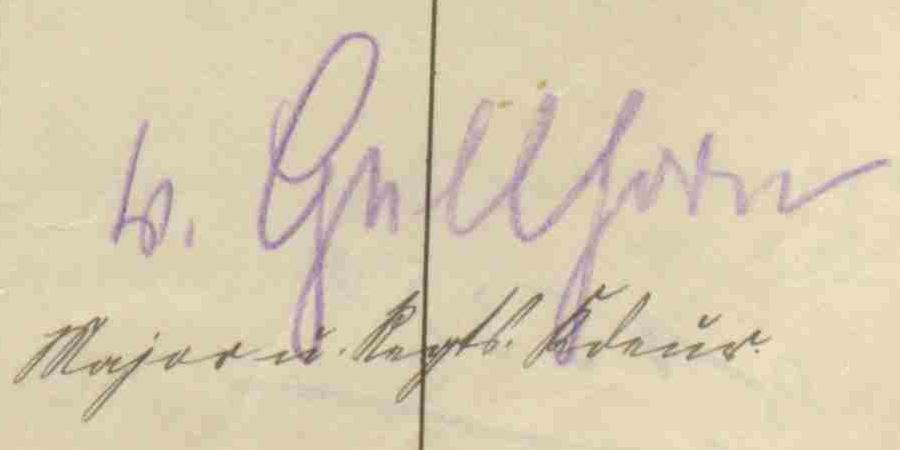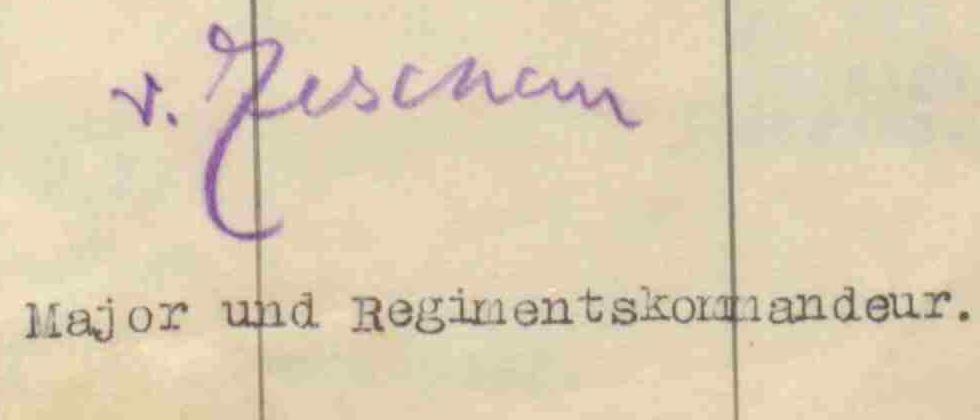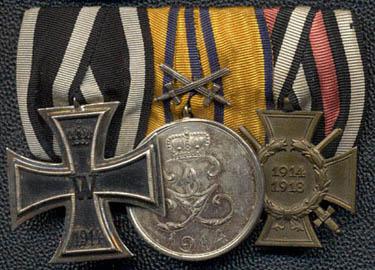-
Posts
4,908 -
Joined
-
Last visited
-
Days Won
97
Content Type
Profiles
Forums
Blogs
Gallery
Events
Store
Everything posted by Dave Danner
-
Your medal bar also represents another rabbit hole, one I tried for a while. This is a way of collecting the state awards of the different German states in the form of a classic trio common to many veterans, especially common soldiers who wouldn't have lots of decorations and service medals. The basic trio - Iron Cross, state award, Ehrenkreuz für Frontkämpfer - is a nice way to display the state award rather than just having the loose award.
-
Werner Grimm received the HOH3X on 18.8.17 as a Hptm.d.R. in the 5.GFAR. Grimm, Werner Ludwig, *15.6.1883 auf Hof Kreien bei Lübz, Mecklenburg Landwirt auf Hof Bobzin bei Lübz; Lt.d.R. (Schwerin) der Feldart.-Schießschule (Pat. 10.4.06), 24.12.14 OLt.d.R., z.Zt. im 6.GFAR, 4.7.16 Hptm.d.R., z.Zt. im 5.GFAR, 3-mal verwundet; HOH3X (18.8.17), MMV1, ÖM3K, VAw His brother Karl also received the HOH3X and MMV1: Grimm, Karl Heinrich, *10.4.1889 auf Hof Kreien bei Lübz, Mecklenburg Lt.d.R. (Schwerin) des FAR 14, 20.4.18 OLt.d.R., RFAR 21 HOH3X (27.9.18), MMV1 Their oldest brother Adolf received the MMV2: Grimm, Adolf Gottfried, *29.11.1880 auf Hof Kreien bei Lübz, Mecklenburg, †1968 Gutsbesitzer auf Augustfelde bei Zuckers; OLt.d.L.-Inf. II (Schlawe), früher von d. Res. des FR 86, 27.1.15 Hptm.d.L., z.Zt. im IR 141, 1916 in Gefangenschaft geraten. EK2, LD2, MMV2 A Leutnant der Landwehr also received the MMV2 while with the Gericht of the stellv. IX.AK. This was likely the Lt.d.L.-Inf. I (Rostock) promoted on 8.8.15 while in the Ersatz-Bataillon of RIR 76. I can't say for certain, but I think this was their fourth brother, Gottfried Karl Grimm, *14.9.1887 auf Hof Kreien.
-
Georg von Jarotzky was a Fabrikbesitzer in Insterburg and Major d.L.a.D., previously an active officer in IR 45. Jarotzky, Georg Feodor Jaroslav von, *10.6.1863 in Görlitz 11.02.1882 Sekondelieutenant 14.05.1890 Premierlieutenant 27.01.1896 Hauptmann (12.09.1895*) 22.03.1903 der Abschied bewilligt under Anstellung bei den Offizieren der Landwehr-Infanterie II 19.11.1909 der Abschied bewilligt 16.06.1913 Charakter als Major d.L.a.D. 10.05.1915 Patent seines Dienstgrades, z.Zt. Bataillons-Kommandeur im LIR 4 18.01.1903 Roter-Adlerorden 4. Klasse 22.03.1897 Kaiser-Wilhelm-Gedächtnismedaille * He had an earlier Patent in the 1908 rank list of Reserve and Landwehr officers, so either an error or he may have been vorpatentiert at some point. Walter Jenewein was a Kaufmann in Hamburg. As an IR 76 officer and Hamburg resident, he doubtless also had the Hamburg Hanseatenkreuz. Ludwig Jenewein was in IR 30 and IR 459, †20.9.1917. Grigo Jenewein was in FußAR 10 and RFußAR 7, †8.4.1918. Fritz Jenewein was a Württemberger and was in IR 180 and IR 475.
-
Several Reserve-Infanterie-Regiment Nr. 15 officers received the HOH3X on 17.4.1918. One was the Regiments-Adjutant, Lt.d.R. Anton Jacobsen. He had earlier received the SLK in 1916. According to the regimental history, "Zum Ritterkreuz des Hohenzollernschen Hausordens mit Schwertern gab das I. Batl. die Lts. Petersen, Lindau und Leßmann ... ein." There were two Petersens in the regiment, but the I. Bataillon officer was the Bataillons-Adjutant, Lt.d.R. Hans Sophus Petersen. Lindau was Wilhelm, whom we already have, He was Kompanie-Führer of the 1. Kompanie and later Bataillons-Adjutant. I am unsure about Lt.d.R. Leßmann, the Kompanie-Führer of the 1. M.G.-Kompanie. Unlike the others, no HOH3X appears to have been gazetted for him. His might be a mistake in the regimental history.
-
Hptm.d.R. Mock from IR 56 received the HOH3X on 11.10.1917. He is: Mock, Adolf *11.9.1880 in Wesel - Leutnant d.R. des Infanterie-Regiments Nr. 56, 24.11.1914 Oberleutnant d.R., zur Zeit im Reserve-Infanterie-Regiment Nr. 56, 21.1.1916 Hauptmann d.R., zur Zeit ebenda, 2-mal verwundet, Hauptmann d.R.a.D. - Regierungs-Landmesser in Siegburg, 1940 Regierungs- und Vermessungsrat in Koblenz.
-
Hübner, Fritz *8.4.1872 Hptm., FAR 71, 18.6.15 Major, 26.5.18 zur Disposition gestellt und zum Bezirkoffizier beim Landwehrbezirk Thorn ernannt, z.Zt. in der II. Ersatz-Abteilung des FAR 71, 1920 Char. als Oberstleutnant a.D., 1920-1921 Regierungsrat beim Versorgungsamt, Kriegsministerium. Hübner, Johann Georg Adolf *3.7.1874 in Ostrowy, Rußland, †10.5.1939 in Liegnitz Hptm., IR 154, 15.7.18 Major Fritz only listed "EK1 & 2, u.a." among his decorations, so he can be ruled out. Georg was not a Major in time, so he too is out. So you are correct as to Hans. Hübner, Hans Friedrich *31.1.1871 in Wittenberg Hptm., Kriegsschule Cassel (Unif. IR 55), ins Feld mit RIR 83, 28.11.14 Major, xx.11.14 Fhr. III./RIR 252, 14.2.15-xx.xx.xx Rgts.Fhr. RIR 252, 18.8.17 Kdr. I./RIR 83, 19.3.18 Kdr. RIR 83, 22.6.18 erkrankt, Oberstleutnant a.D.
-
There were differences in the design (including the coat of arms and the motto) and the naming of the different classes. The statute ribbon was, I believe, the same, but for the Royal House Order, as with other Prussian orders like the Red Eagle and Crown Orders, awards with swords were typically made on the Iron Cross ribbon (this is a simplification - the variations in Prussian orders is a book in itself). Royal House Order of Hohenzollern, Knight's Cross with Swords: Princely House Order of Hohenzollern, Honor Cross 3rd Class with Swords:
-
Nicolas, Kämper can be ruled out because of the DA. Below are the known (to me) recipients of the AK and the SLK who cannot be ruled out because of other decorations. Wedelstädt, as a Generalstabsoffizier, probably had other decorations we don't know about, so he might be ruled out as well. Polysius and Zach are unlikely - they received the SLK because of their units, and the AK because of their Anhalt citizenship, but had no connection to Oldenburg. Since there are no rolls for the Oldenburg Friedrich-August-Kreuz, we cannot say for certain whether any of them had that cross. However, Gerlach, Gersdorff and Mannlich-Lehmann were 1.GDR officers. Both the Großherzog von Oldenburg and the Herzog von Anhalt were à la suite to 1.GDR, and both made numerous awards of their crosses to that regiment. So each of the three is a likely candidate for your chain and/or the medal bar. Mannlich-Lehmann was a cadet or Fahnenjunker in Berlin at the time of the wedding, so he might have participated, but been too junior to receive a Braunschweig decoration. Gersdorff was also in Berlin, so he might have participated in the wedding as a civilian. Gerlach, Karl August Bogislav Bernd Hermann Jakob v. *2.12.1883 in Köslin, †11.10.1945 in Friedenshütte, O./S. (verschleppt) 5.Fkherr auf Parsow u. Schwemmin, Kr. Köslin, Herr auf Stadtgut Körlin a.P., Trienke u. Drosedow, Kr. Kolberg, Ref.a.D.; Lt.d.R. (Belgard) d. 1.GDR, OLt.d.R., Rittm.d.R.a.D. EK1, AK (31.1.16), SLK (19.10.16) Gersdorff, Wolfgang v. *20.9.1878 in Kloster Jerichow, Jerichow II Dr.phil., Dramaturg d. Kgl. Schauspiele Berlin; Lt.d.R., 4./1.GDR EK2, AK (30.11.17), SLK (28.8.17) Mannlich-Lehmann, Max Erdmann Felix v. *14.1.1894 in Berlin Fhj., 1.GDR, 18.12.13 Fähnr., 6.8.14 Lt. (Pat. 2.9.14), nach d. 1.WK wohnhaft als OLt.a.D. in Dresden EK2, AK (30.11.17), SLK (7.6.16) Polysius, Otto *22.1.1895 in Dessau Sohn d. Hzgl. Kommerzienrats Dr.Ing. Otto Polysius; 18.9.15 Fähnr., JB 7, Stab XXXIX.RK, 30.7.16 Lt., vorl. ohne Pat., 31.10.17 mit Pat. v. 30.7.16 z.d. Res.Offze. d. JB 7 vers., 1.11.17 verletzt, Lt.a.D. EK2, AK (16.12.15), SLK (18.2.16) Rath, Egon Anton Constantin Richard v. *4.12.1890 in Magdeburg Lt., IR 53, 27.1.16 OLt., Hptm.a.D. EK2, AK (20.5.15), SLK (30.6.16) Wedelstädt, Ludwig Erich Theodor Adolf Wilhelm Martin v. *1.8.1882 in Clötze, Gardelegen, †1954 OLt., kdrt. z. Gen.St. (22.3.02-26.12.14 im IR 26), 19.10.14 Hptm.i.G. (Pat. 8.10.14), Hptm.i.G., Gen.St. VII.RK, Gen.St. AOK 2, Maj.a.D. EK1, AK (3.12.15), SLK (29.12.16) Zach, Karl *5.10.1888 in Coesfeld 20.12.11 Dr.phil. (Berlin), Chemiker in Dessau; Lt.d.R. (Dessau) d. HR 7, 7.Art.Mun.Kol. d. XVI.AK, OLt.d.R., Adj. d. Kdr. d. Mun.Kol.u.Tr. d. XV.RK EK2, AK (29.2.16), SLK (26.4.15)
-

Translation from Bulgarian to English please
Dave Danner replied to Gordon Craig's topic in Central & Eastern European States
If it's the same as Soviet practice, these little books listed all your awards. -

Transcription confirmation
Dave Danner replied to Dave Danner's topic in Deutsche Kaiserreich: Man spricht Denglish
Thanks! I found another recommendation from the same commander with similar wording. Despite the bad handwriting, this appears to confirm "dienstliche". However, in this one, either "Bewährung" has replaced "Berührung", as in the first recommendation, or I misread that one. Any thoughts? -

Transcription confirmation
Dave Danner replied to Dave Danner's topic in Deutsche Kaiserreich: Man spricht Denglish
I had that thought as well. Does that make sense in context - "besondere dienstliche Tüchtigkeit"? -

Transcription confirmation
Dave Danner replied to Dave Danner's topic in Deutsche Kaiserreich: Man spricht Denglish
One more, for a Gefreiter in a Divisions-Brückentrain: "Besondere [__nstliche] Tüchtigkeit, Berührung auch im feindlichen Feuer." -
I have no idea which Major von Gellhorn commanded Landwehr-Infanterie-Regiment Nr. 22 in 1917, so I will go ahead and post it here. Similarly, I have no idea which Major von Zeschau commanded Landwehr-Infanterie-Regiment Nr. 51 in 1917, presumably one of the Saxons rather than the Prussian Walter who was a cavalry officer.
-
There is no connection between where one served and whether one had the Austrian, Bulgarian and/or Hungarian war commemorative medals. As scottplen says above, you simply applied for them. Some applied for all three, some for none, and some for a combination of them. 2300 is what Nimmergut gave for one version (late war zinc). There were about 15000 awards according to Stijn David's research. The Bravery Medal was mainly awarded to Saxe-Altenburg citizens or to members of Saxe-Altenburg contingents. The main one of these was Infanterie-Regiment Nr. 153, which accounts for over 5000 awards. There were also Landwehr-Infanterie-Regiment Nr. 36 with about 500 awards and Reserve-Infanterie-Regiment Nr. 264 with about 300 awards. A number of other units also received upwards of 100 or more medals, but these would have been mostly to Altenburg natives in those units. These include IR 184, IR 361, RIR 66, RIR 231, LIR 93 and Landsturm-Infanterie-Bataillon Altenburg IV/6.
-
By princely decree dated 1 January 1916, silver swords were authorized for awards of the Silberne Medaille für Verdienst im Kriege when awarded on the ribbon of the Ehrenkreuz for merit "vor dem Feinde". For war merit in the Etappe or Besatzungstruppen, the medal was awarded on the blue ribbon without swords. Gilt swords were authorized for the ribbon of the Ehrenkreuz.
-
Now the question I have, which I have had no luck finding a definitive answer to, is this: Is this Heinrich Krumme the same as the Heinrich Krumme born 22.10.1894 who was a Hptm.d.R. (RDA 01.08.38) and then Maj.i.G.d.R. (RDA 01.05.42), Friedensdienststelle Bochum, 01.05.42-15.06.44 Ib 199.ID, 30.08.44-25.11.44 beim OQu. d. Wehrm.Bfh. der Niederlanden, 01.12.44-25.02.45 Ic II.Armeekorps, 20.03.45 Außenstelle GenQu. im WKr. X?



